Shropshire Association of Woodturners
Event Reports for 2015
March: Demonstration by Paul Jones RPT
The calendar had Paul demonstrating spindle turning and he announced that he would be making a three piece candle stick. Within the design there would be spindle turning (which he said he preferred to call parallel turning) but the base would be turned cross grain. He had chosen beech and sycamore for the demo
The new room layout was a success and members left with a questionnaire to fill in and return by the April meeting. Submission of the completed form will entitle members to a draw entry to ‘win’ the prize of half price subs next year.
Finally, congratulations to John Gibbons for his first and second places and Chris Hart for his third place in the inaugural turning challenge.
Better luck next time to those who entered – there was an unprecedented number (15 people entered 27 items between them). Remember, each member can enter up to three items per challenge and one point is accrued for each entry regardless of any judging points. The challenge for 25th March is a Goblet – max. 10 inches tall. Good luck.
See pictures of the demo, entries and winners in the gallery.
First up was the base which he mounted on a screw chuck. He reminded us, when roughing down a cross-grain square-edged block, not to use a tool that had a tang and to use one that had a solid bar in case the tool caught and the tang snapped. Once in the round he turned a spigot for his chuck. Now held in the chuck he drilled the mortice for the stem and finished the ogee shape of the base.
The top was next. Turned between centres he first roughed down the blank then produced a chucking spigot on both ends. Mounted in the chuck the blank was drilled to take the stem upper spigot, then reversed and drilled for the candle holder and the flat top and heart-shaped body were formed.
The final part of the project was the stem. Again turning between centres Paul produced a very graceful column with a spigot at both ends. He showed us a way to ensure a snug fit of the joints when assembled. The spigots were turned fractionally smaller than the mortices then using a skew chisel he cut several shallow grooves on the spigot to lift the surface (when assembled the rough surfaces of the spigots are compressed and ‘grip’ the sides of the mortices).
For me, the most impressive things about Paul’s demo (in no particular order) were his good lathe procedures, good and informative delivery, good tips and very precise and fine turning which hardly needed sanding (in fact he didn’t sand anything).
An example to us all. Thank you Paul. An excellent evening.
See pictures of the demo, entries and winners in the gallery.
Tim Aaron
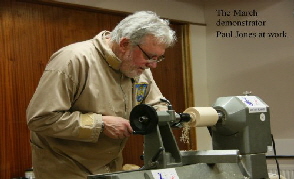
February: Demonstration by Steve Heeley RPT
Steve kicked off our 2015 meetings with a very entertaining demo of ‘wet’ turning. He chose to show us how to turn an eight inch diameter piece of Oak branchwood into a natural edged vase.
Having turned the inside to the required shape and carefully preserved the natural bark edge on the rim he began to work his way down the vase. Using a pose able lamp shining inside the vase it was possible to see how he used the colour of the light showing through the vase side to determine how thick the sidewalls were. The room lights were dimmed and made the viewing of the procedure quite spectacular!
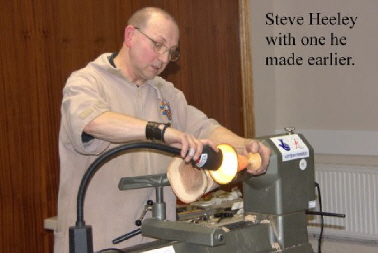
April:
The meeting format was an open/club evening and, according to feedback, was a great success. Many non-members came along and the informal atmosphere allowed us to make contact with intersted visitors and prospective new members.
The very nature of the evening meant that it was a little unstructured but we have learned from it and will have a list of activities and their aproximate start times written up on the white board.
Of course, the ‘Challenge’ was one of the parts of the evening and threw up an unusual outcome. The entries were all of a high standard and the judges found their task quite difficult and for the first time, in my experience of competitions of this sort, three entries were awarded the same winning points! Congratulations to Alan Walters (with two entries)and Stuart Ray for their first place achievements.
The tool sharpening demonstration and practical help was extremely well appreciated by us all. Grateful thanks go to Dave Carley for his expertise and instruction. I hope that Dave will repeat it at our next club nights (I’ll have to buy him more of his usual to twist his arm!).
Andrew Thomson gave a ‘warts-and all’ talk on the trials and tribulations of the learning process making his wooden ribbon challenge entry. New things are OK when they go right first time but as Andrew found (and described) the different techniques required really could test ones patience. He produced a hand-out so that we could all have a go. There is possibly an opening here for other members to give us an insight into how they have achieved making a tricky item with a short 5 minutetalk.
Skew chisel use was demonstrated to beginners and visitors and was well received. We may have to do something similar with skews and gouges at future club events due to feedback in the recent questionnaire. Saturday morning teach-ins look like the way to fill the need for most respondents to the questionnaire. Tim Aaron
May:
John Berkeley was the demonstrator at our May meeting and he lived up to expectations inspiring many of us to try turning screw threads to enhance our boxes. He has a really good delivery and oodles of skill making for a very entertaining and enlightening evening. As well as finishing a threaded box project he captured our interest by showing us other boxes – all different – with inlayed woods and other materials set into the lids. Texturing of some of them really made the forms special. The box that he’d made for our demo was given to the club to raise funds – a very kind gesture. Thank you John. He also brought along his wife Chris who manned a sales table which was well patronised and the club bought a DVD of his teaching the use of the ‘unichaser’. I suspect that it will be a favourite loan item from our library by those who bought or have the tool.
As has become usual, the ‘Challenge’ brought out some very fine turning. John Gibbons and Lofty Marshall edged the others out of the ‘medal’ positions. Hopefully, you’ll have a go at the challenge for June which is a rice bowl with a pair of chopsticks. Good luck.
Tim Aaron
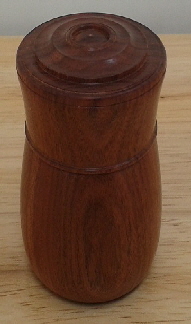
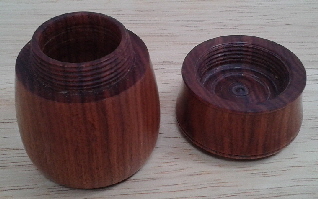
The Big Art Show 2015
The club was invited to attend and demonstrate at this years BAS, in Shrewsbury, free of charge. A handful of club and committee members manned the ‘stall’ on the Friday, Saturday and Sunday 3rd, 4th and 5th of July. We set up the marquee display on the Thursday afternoon (in the rain!) and dismantled it all on Sunday afternoon (in the rain again!).
The visitors to the show enjoyed our simple demonstrations of turning and lots promised to give the club a try so watch out over the coming months for new faces and make them welcome. Some of our club members provided items for display and also for sale. The items on our displays drew very favourable comments and generated interest in the techniques used by the turner.
The effort was worth it for the exposure we achieved and the interest shown by prospective visitors/members. The items that were turned in the demos were usually given to the audience who were very pleased and surprised! Thank you to all those who made the effort to help and who came along to give us their support.
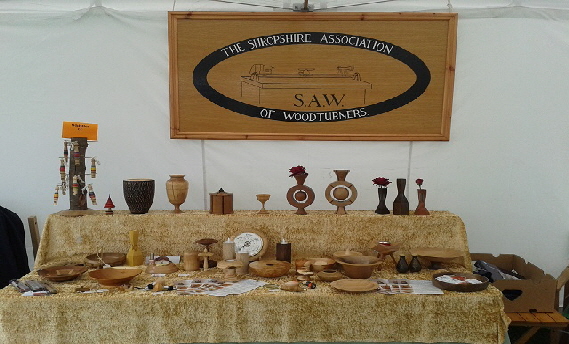
July:
Our demonstrator for July was Alan Trueman who gave us a very fine display of various turning disciplines. The members and visitors who are fairly new to turning couldn’t have been shown better procedures with his knowledge and awareness of safety whilst using the combination of lathe and tools. The subject of the demo was a lidded jewelery box with finial
Alan turned the base first using bowl turning techniques. Having finished off the underside of the base he turned the item around and completed the upper sufaces. After each and every stage of turning he power sanded before sealing the wood with sanding sealer diluted to half strength with cellulose thinners. The final finishing medium was a wax product buffed to a high gloss.
The lid was next up and completed expertly to incorporate a saucer-like shape, to match the base, for small items of jewelery. The final part of the project was the finial turned between centres (which apart from being a useful handle made a great way to keep rings tidy!). A really interesting demo and Alan donated the blanks necessary to make the project to the club as a raffle prize. Many thanks Alan.
There were 9 entries in the Challenge to produce ‘a wearable item’- once again all of a very high standard in design and finish. Congratulations this month go to Ian Kippax, Andrew Thomson and Alan Walters. Next month the ‘Challenge’ is to make a box (yes, lidded Alan) which is less than 4” tall and greater than 2” in diameter.
Tim Aaron
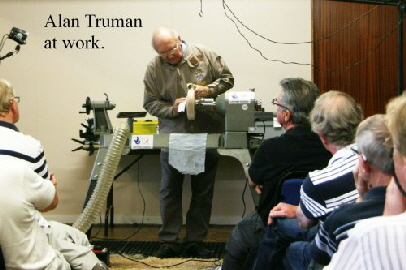
August:
Our last meeting, an open club evening, on 26th August was a great success with a good turn out of members and visitors. Two 2 new members joined – a warm welcome to them. The evening was better structured than our first attempt and we all benefitted from a very interesting demo of captive ring turning by Andrew Thomson. Those who took up his invitation to ‘have a go’ were very taken with the concept and Andrew’s instruction. Thank you Andrew. Martin Jobe did a fine job on the tool-sharpening table and after he left it was gratifying to see that other members were continuing to use the Robert Sorby equipment (which was very kindly lent to us for the evening by Dave Carley – many thanks Dave). We also got some interested members using the club lathe learning how to use a skew chisel safely with really good results. All that’s needed now is practice, practice, practice.
The next meeting, on 23rd Sep, will be a demonstration by Gerry Marlow. This will be your best/last opportunity to get your ticket(s) for the all day seminar on 3rd Oct with Tracy Owen – don’t forget, we need to be able to cater for the (included in the price) hot lunch. The ‘Challenge’ voted for, for the 23rd Sep meeting with Gerry, is a ‘Bud Vase’. There will not be a challenge for the Seminar meeting or the AGM. On the subject of the challenge I was gratified to see that the August ‘Box’ challenge was well attempted by members, with a magnificent field of 18 – well done to you entrants. Congratulations go to the placed entries: first place went to Stuart Ray and in joint second place were Ian Kippax and John Gibbons. Well done. .
Saturday morning ‘Teach ins’ are about to begin with the first recipients scheduled for the 12th Sep and the list is open for the second date (10th Oct). We’ll use the club equipment in our usual meeting place from 0930 to 1230 on each day. Once there are no more takers for ab initio tutoring I intend to expand into more advanced topics such as finishing, colouring and texturing plus anything that members would like help with (provided we have someone who can help!).
Tim Aaron.
September:
Gerry Marlow was our demonstrator this month and he produced a very interesting evening for us. We had a good turnout of members and visitors who all seemed to really enjoy the evening.
The first thing that Gerry did was metal spinning to produce a five inch diameter bowl and he followed that up with candlestick inserts. Specialist tools apart it was something that I’d like to try but apparently Gerry had made his own and there doesn’t seem to be a manufacturer who makes them. However, it was fascinating to watch the disc of aluminium morph into a candlestick insert.
The rest of Gerry’s demo was three different off-centre turned candlesticks. He had us transfixed with the way he mounted the blanks and the shapes that he made. Then to cap it all he donated the candlesticks to the club to raise funds. Many thanks indeed Gerry.
The ‘Challenge’ brought out the best in the 13 entries from the 7 members who entered items. The variety of bud vases entered showed great diversity, fine turning and finishing. It was good to see a ‘new’ winner this time, so congratulations to Trevor Abbotts for his entry and well done (again) to second place Alan Walters and third place John Gibbons.
Some changes to the ‘challenge’ will be announced at the AGM in November which I hope will open it up to more members.
Tim Aaron
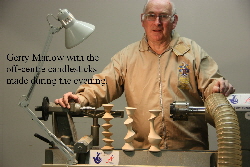
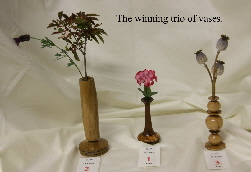
Seminar Write-up
Tracy Owen was our demonstrator for the October 3rd ‘All Day Seminar’ and what a day of inspiration and truly professional techniques he gave us. A day like our seminar doesn’t just happen and a lot of hard work and thought had gone into it. Obviously you would expect your committee to do the organising etc. on your behalf but I would like to give my grateful thanks, here in print, to our amazing secretary Carol. This event and infact this year wouldn’t have been half as good as it was without Carol’s seemingly inexhaustable energy and attention to detail (by the way, we loved the beef stew and dumplings!).
Back to the seminar. Tracy’s style and skill were perfect for the assembled audience as was shown at the end by the enthusiastic rounds of applause he received. We were swelled in numbers by five guests who all fitted in with us well and who really enjoyed the whole experience. The first of three items Tracy made was a shallow bowl with a wide decorated rim. The wood blank was maple about 40cm diameter and 6cm thick. Using a screw chuck he formed the underside in an ogee shape then reversed it into a scroll chuck to turn the upper surface. The face was cleaned up and a 10cm bowl/cup was produced in the centre. Next came the fun part when he used a ‘Lancelot’ chainsaw blade (on an angle grinder) to texture the face of the work. [This type of blade is unforgiving and dangerous if used without great care – a point that Tracy emphasised throughout] The upper suface, after de-nibbing, was ebonised with multiple layers of black spray (with periods of drying) and put aside until after lunch for final finishing. Time now for tea/coffee and biscuits…
After the break the next item was a hollow form turned from a 40cm by 17cm block of ‘green’ ash. The block was turned into the round between centres and a rough shape formed. It was to take the shape of an elongated drop of liquid – very narrow at the top swelling out to around 15cm at its widest point then round to the small foot. Before the neck was turned to size the piece was parted about 2/3 up from the base. The lower part was hollowed out and removed still held in the chuck. The upper part was the mounted in another chuck and also hollwed but only partly. Both pieces were brought together and superglued whilst taking care to match the grain. Once set the neck was turned to keep the flow of the shape up to the narrow end and a very narrow hole was bored. The join was hidden by turning three beads, the groove of one being the join. Ozmo oil was applied as the finish and the hollow form was parted off.
After our splendid lunch, the first item was finished off with the application of silver gilt cream to the high points of the ebonised area to give a metal effect and the small ‘cup’ in the centre had a few further cuts to restore the silky white colour of the maple by removing the excess ebonising. All the bare wood was treated with ozmo oil and buffed to a finish. Time now for tea/coffee and cakes…
The final item was to be a box made from a yew branch 30cm long by roughly 10cm diameter. Once turned to the round between centres the piece was parted in half. The box part, still in the chuck, was turned into an apple shape, hollowed out and the inside finished with oil. The top half of the project was to be the lid and finial in one piece. Once roughly in shape the lid ‘tenon‘ was made to fit the box and pushed into place to provide the drive for turning and finishing the lid and finial. Oil finish again.
Three superb demonstrations of quite different items – wonderful inspiration for us all to go away and try to emulate Tracy’s skill. Thank you, Tracy, for a great seminar . See you next year.
Tim Aaron